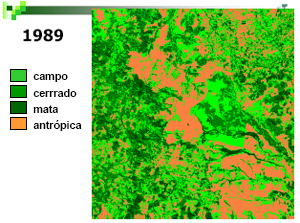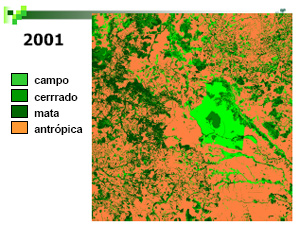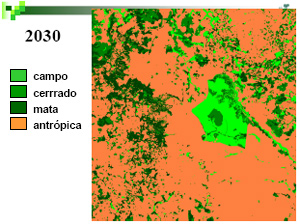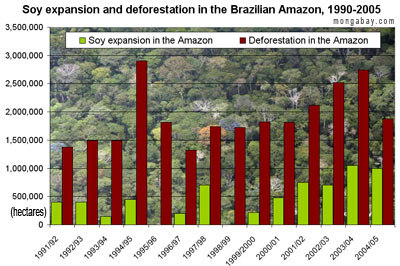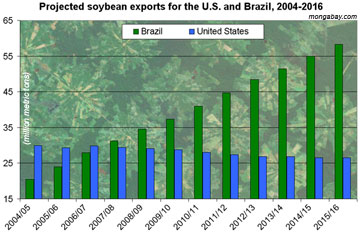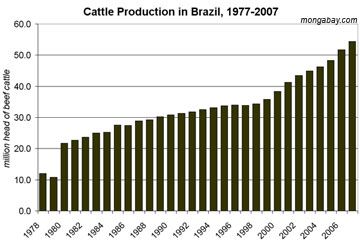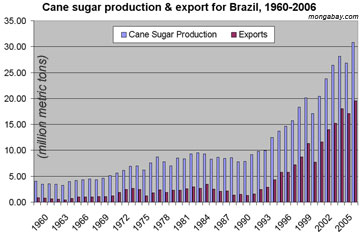Biofuels driving destruction of Cerrado savanna in Brazil
Biofuels driving destruction of Brazilian cerrado
Rhett Butler, mongabay.com
August 21, 2007
Demand for biofuels is driving the destruction of Brazil’s cerrado, one of the planet’s most biodiverse savanna ecosystems.
The cerrado, wooded grassland in Brazil that once covered an area half the size of Europe, is fast being transformed into croplands to meet rising demand for soybeans, sugarcane, and cattle. The cerrado is now disappearing more than twice as the rate as the neighboring Amazon rainforest, according to a Brazilian expert on the savanna ecosystem.
“The Cerrado was pretty much intact until the 60s, when most of the relevant economic activity was the cattle ranching,” Dr. Ricardo Machado, author of a recent Conservation International (CI) study on the cerrado, told mongabay.com. “During the 70s, when new technologies and new varieties of plants (corn, soybean, rice, wheat, eucalyptus, and grasses for livestock) where introduced the Cerrado became an important region for the Brazilian agribusiness. More and more native areas were cleared to be converted for planted pastures (using African grasses) or croplands. The natural vegetation removed was converted to charcoal to be used by the steel industry.”
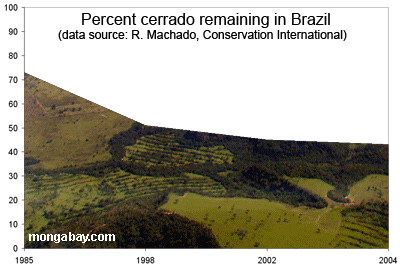
Remaining cerrado cover in Brazil according to Dr. Machado |
Machado estimates that the area of cerrado of a percentage of its original 204 million hectares in extent, has fallen from around 73 percent in 1985 to around 43 percent in 2004. He believes that the area occupied by pastures and croplands has likely increased since then, given the substantial rise in Brazil’s agricultural production and land prices, and pegs annual loss at 2.2 million hectares every year, or about 1.1 percent of the remaining cerrado. By comparison, Brazil’s Amazon rainforest lost about 10.7 million hectares between 2002 and 2006, 2.1 million hectares or about 0.5 percent per year.
Scientists say conversion of the cerrado for large-scale soybean farms, sugar plantations and cattle pasture is indirectly fueling deforestation in the rainforest, by pushing small-scale farmers and land speculators deeper into forest areas while spurring road and infrastructure development.
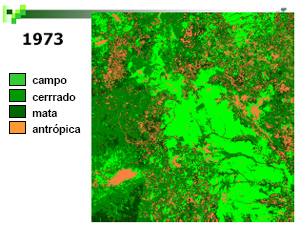
Past and projected vegetation cover near Parque Nacional de Emas, Brasil. Presentation by Dr. Machado at the “Expansion of energy crops and the impact on Brazilian ecosystems” Workshop sponsored by CI and FBDS |
“Soybean farms cause some forest clearing directly. But they have a much greater impact on deforestation by consuming cleared land, savanna, and transitional forests, thereby pushing ranchers and slash-and-burn farmers ever deeper into the forest frontier,” said Philip Fearnside, a researcher at the National Institute for Research in the Amazon in Manaus, Brazil. “Soybean farming also provides a key economic and political impetus for new highways and infrastructure projects, which accelerate deforestation by other actors.”
William F. Laurance, president of the Association for Tropical Biology and Conservation (ATBC) and a senior staff scientist at the Smithsonian Tropical Research Institute, agrees.
“Soy farming is having a huge impact in the Amazon right now, for three reasons,” Laurance told mongabay.com. “First, industrial soy farmers are themselves clearing a lot of forest. Second, soy farmers are buying up large expanses of cleared land from slash-and-burn farmers and cattle ranchers, and the displaced farmers and ranchers often just move further out into the forest, maintaining a lot of pressure on frontier areas. Finally, the soy farmers are a very powerful political lobby that is pushing for major expansion of roads, highways, river-channelization projects, and other transportation that will criss-cross large expanses of the Amazon. This infrastructure is acting like Pandora’s box–it is opening up the frontier to spontaneous, unplanned colonization and exploitation by ranchers, farmers, hunters, and illegal gold miners.”
Dr. Daniel Nepstad of the Woods Hole Research Center says that the growing demand for corn ethanol means that more corn and less soy is being planted in the United States. Brazil, the world’s largest producer of soybeans, is more than making up for shortfall, by clearing new land for soy and sugar cultivation.
“We see soy prices going up partly because less soy is being grown in the U.S. as corn expands to meet the surging demand for the emerging ethanol industry,” Nepstad told mongabay.com. “Similarly as sugar cane expands in southern Brazil, soy production is heading northward, encroaching on the Amazon.”
Nepstad expects land-clearing to accelerate as Western countries continue to shift towards ethanol and soy-based biodiesel. For example, despite a 51-cent-per-gallon subsidy for American corn ethanol producers and a 54-cent-per-gallon tariff on imported ethanol, the U.S. imported about 500 million gallons — 73 percent of its total ethanol imports — from Brazil in 2006. A new accord between the countries is expected to eventually reduce the tariff, leading to higher U.S. imports.
“The future of Cerrado is not good if the current trends persist,” added Machado.
Better the cerrado than the rainforest?
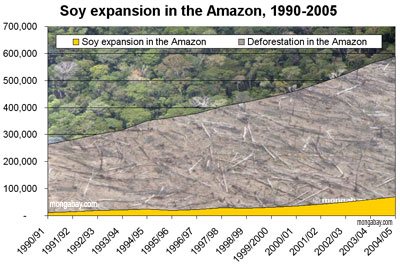
Soy expansion in the Brazilian Amazon, 1990-2005 Total deforestation and area of soybean cultivation across states in the Brazilian Amazon. Overall soybean cultivation makes up only a small portion of deforestation, though its role is accelerating. Further, soybean expansion and the associated infrastructure development and farmer displacement is driving deforestation by other actors. Note: some soybean farms are established on already degraded rainforest lands and neighboring cerrado ecosystems. Therefore it would be inappropriate to assume the area of soybean planting represents its actual role in deforestation.
Annual deforestation rates and annual soy expansion for states in the Brazilian Amazon 1990-2005. Note that the 1995-1996 and 1998-1999 years were negative and do not show up on the chart. Graphs based on Brazilian government data. |
Nevertheless, not everyone agrees that clearing of the cerrado is a problem.
Dennis T. Avery, senior fellow for Hudson Institute in Washington, DC and the Director for Global Food Issues, says that environmental groups should be happy that growth of Brazilian agriculture in concentrated in the cerrado rather than the Amazon rainforest.
“Greenpeace should be thankful that Brazilian scientists have developed acid-tolerant soybean varieties that grow successfully on millions of acres of acid, brushy “cerrado” on Brazil’s central plateau,” Mr. Avery wrote in a 2006 editorial published in the Canada Free Press. “Cerrado is not rain forest. It’s scrub land. Some of the cerrado is near the Amazon rain forest. Fortunately, those former wastelands are now helping provide better diets for millions of kids around the world because of high-tech plant breeding–instead of clearing huge tracts of the actual rainforest.”
Likewise, many Brazilians see the development of the cerrado for agriculture as an important economic opportunity. In less than a generation the cerrado has helped Brazil become an agricultural superpower — the world’s largest exporter of beef, cotton, and sugar, among other products. Landowners in the region have seen their land values double every 4-5 years in areas that just a decade ago were wildlands. The market is driving deforestation and land conversion.
Finding solutions
For this reason, some believe the market is the best way to slow conversion of cerrado and neighboring ecosystems.
Aliança da Terra, an organization founded by a Texas rancher named John Cain Carter and his wife Kika, believes that by giving producers incentives to reduce their impact on the environment, the market can succeed where conservation efforts have failed.
While environmental degradation rates in the Amazon region have accelerated since 2000, the problem is not a lack of laws, but rather a legal system where enforcement is so slow and so corrupt that it renders the laws effectively useless. On paper, farming and cattle ranching in the Amazon may be the most restricted in the world, with landowners required to keep 50-80 percent of their land forested. Carter wants to see farmers in Brazil benefit in following the law, by turning this restriction into a marketing advantage. However in order to do so, Amazon producers have to ensure that consumers ( i.e., buyers of commodities like McDonalds, Wal-Mart, and Cargill) can confidently say that agricultural products are produced legally and even more sustainably than stipulated by the law. The incentive for producers is market access: Aliança da Terra helps Brazilian farmers and ranchers get the best price for their products, but only if they follow the rules. While producers get higher prices for their goods, buyers like Burger King and Archer-Daniels Midland can say they are using legally and responsibly produced agricultural products. Meanwhile more forest is left standing, ecosystem services are preserved, and biodiversity is conserved.
“We’re setting up an accrediting mechanism that will help responsible landowners gain access to markets and get the best price for their products,” Cater explained. “We want market recognition for shouldering this conservation burden. Where else in the world do you have landowners who have to keep 50 percent of their land forest? Nowhere. If the consumer is supposed to benefit people for doing that then you tip the scales back in favor of the landowner and its going to create more positive feedback for people to follow the rules by maintaining the forest. As it is right now there’s nothing to keep forest standing because the law doesn’t catch you in time and you can always bribe your way out of it if you do get caught.”
“We’re trying to turn this forest reserve law from a negative into a positive, or make lemonade out of lemons, so to speak,” Carter continued. “People think farmers in the Amazon are bandits so we’re trying to show there are good people who are trying to make a difference and reduce their impact.”
Aliança da Terra is not the only group thinking along these lines. Last year, after an investigation by Greenpeace linked Amazon soy to chicken feed used to supply McDonald’s and other fast-food restaurants in Europe, a consortium of Brazil’s largest soy crushers announced a two-year moratorium on trading soybeans grown on newly deforested lands in the Amazon basin. During that time the agricultural sector will work with the Brazilian government to prepare an effective mapping and monitoring system for the Amazon biome, develop strategies to encourage soy producers to comply with the Brazilian forestry laws, and work with other groups to layout rules on how to conduct operations in the region.
It is possible that some of the recommendations will be extended to production in the cerrado, where some firms are already acknowledging the need for more responsible practices.
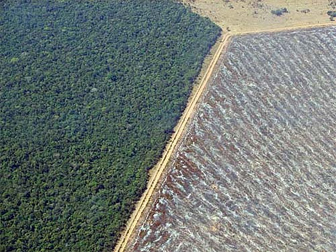
Fire guards insure the survival of remaining forest reserves. Credit Aliança da Terra |
“We have an explicit policy of not clearing native vegetation, and we don’t subcontract to farmers who do,” wrote Marcelo Vieira, Sugar and Ethanol Manager at Adecoagro, a Brazilian firm owned by prominent investor George Soros, in comments posted in response to a Washington Post article. “We have an explicit policy of not clearing native vegetation, and we don’t subcontract to farmers who do. Adecoagro restores land surrounding springs, streams, wetlands, steep hills, hilltops and other sensitive areas. As part of this program, we are restoring and setting aside reserves equal to 20 percent of our farmland, as Brazilian law requires. Finally, our ethanol projects are in the state of Mato Grosso do Sul, not in the Cerrado.”
Vieira says that higher land prices are driving more efficient use of the cerrado.
“We see that as ranchers lease land for sugar cane and see property values rise, they invest in efficiency, keeping the same herds on less land,” he continued. “Brazilian ranchers have historically been very inefficient because of the low value of land. This is changing fast with the expansion of agriculture.”
The Brazilian government has said that part of the solution may come from making better use of already cleared land. Last October at the opening of an organic food products fair in Sao Paulo, agriculture Minister Luis Carlos Guedes Pinto said that Brazil could cultivate an extra 50 million hectares “without cutting down a single tree” by using only degraded pasture. According to CI’s Machado, the Brazilian government plans to invest US$30 million through a GEF project in conservation actions in the cerrado.

|
“We need to incorporate conservation issues on our development plan for the region,” Machado added. “Conservation of biodiversity on private lands, respect for local indigenous cultures and traditional communities, restoration of degraded areas, protection of headwaters, creation of financial mechanisms for ecosystem services payments, carbon credits for avoided deforestation and environmental education are some initiatives that must be implemented immediately.”
Whatever happens in the cerrado, scientists say the biome — which ranks as the world’s most biologically rich savanna — is important. Home to more than 10,000 species of plants (4400 of which are endemic), 847 species of birds, and almost 300 mammals, recent research indicates that the ecosystem provides important watershed services and plays an integral role in carbon cycling.
“Many leaders and decision-makers wrongly justify this deforestation because the Cerrado is not covered with dense tropical forests like the Amazon or the Atlantic Forest,” said Machado. “This reaction ignores the fact that the biome harbors the richest savanna in the world, with abundant biodiversity and watershed resources that are of great importance for Brazil.”
Related articles
Brazil’s grasslands could replace food production of American heartland
Today when Brazil is mentioned in the same sentence with “agriculture,” people often first envision the Amazon rainforest giving way to soybean plantations and cattle farms. While the Amazon is being converted for such purposes, the cerrado, a vast area of savanna-like grasslands covering more than 20% of the country’s surface area, is increasingly under threat as farmers from the United States and Europe are setting their sights on the biome’s sizeable agricultural potential.
Can cattle ranchers and soy farmers save the Amazon?
John Cain Carter, a Texas rancher who moved to the the Brazilian state of Mato Grosso 11 years ago and founded what is perhaps the most innovative organization working in the Amazon, Aliança da Terra, believes the only way to save the Amazon is through the market. Carter says that by giving producers incentives to reduce their impact on the forest, the market can succeed where conservation efforts have failed. What is most remarkable about Aliança’s system is that it has the potential to be applied to any commodity anywhere in the world. That means palm oil in Borneo could be certified just as easily as sugar cane in Brazil or sheep in New Zealand. By addressing the supply chain, tracing agricultural products back to the specific fields where they were produced, the system offers perhaps the best market-based solution to combating deforestation. Combining these approaches with large-scale land conservation and scientific research offers what may be the best hope for saving the Amazon.
Globalization could save the Amazon rainforest
The Amazon basin is home to the world’s largest rainforest, an ecosystem that supports perhaps 30 percent of the world’s terrestrial species, stores vast amounts of carbon, and exerts considerable influence on global weather patterns and climate. Few would dispute that it is one of the planet’s most important landscapes. Despite its scale the Amazon is also one of the fastest changing ecosystems, largely as a result of human activities, including deforestation, forest fires, and, increasingly, climate change. Few people understand these impacts better than Dr. Daniel Nepstad, one of the world’s foremost experts on the Amazon rainforest. Now head of the Woods Hole Research Center’s Amazon program in Belém, Brazil, Nepstad has spent more than 23 years in the Amazon, studying subjects ranging from forest fires and forest management policy to sustainable development. Nepstad says the Amazon is presently at a point unlike any he’s ever seen, one where there are unparalleled risks and opportunities. While he’s hopeful about some of the trends, he knows the Amazon faces difficult and immediate challenges.
Hudson Institute fellow calls Amazon savanna biome a wasteland
In an April 21st, 2006 editorial published in the Canada Free Press Dennis T. Avery, senior fellow for Hudson Institute in Washington, DC and the Director for Global Food Issues, called Brazil’s cerrado ecosystem a “wasteland” and criticized a recent report from the environmental activist group Greenpeace that linked Amazon deforestation to soy-based animal feed used by fast-food chains in Europe
Two unknown ‘dragon’ species discovered in Brazil
Two previously unknown species of lizard that are said to resemble miniature ground-dwelling dragons have been found in the threatened cerrado region of Brazil. The species, Stenocercus squarrosus and Stenocercus quinarius are described in the current issue of the South American Journal of Herpetology.
